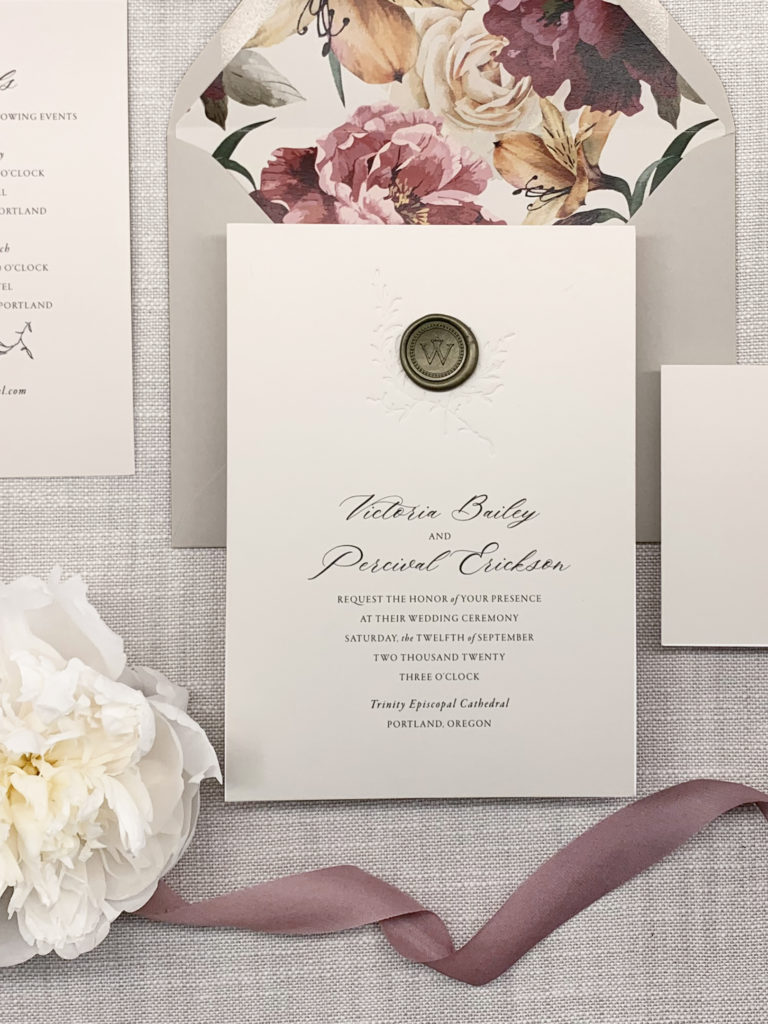the striking elegance of
embossing and debossing
printing terminology | beautiful invitations

If you’ve received a wedding invitation in the mail or have been handed a new business card recently, there’s a pretty good chance that you noticed something quite eye-catching on that little piece of paper. You’ve probably noticed the way the letters or images stand out a bit more, or the colors give the illusion of being sunken in. No, your eyes aren’t playing tricks on you. There’s actually a term for those types of printing styles, they are called Embossing and Debossing. Both are uniquely different and have some pretty amazing after effects, so if you are still reading and still interested, we would love to help give you a little run-through on why these styles are so special and why we love them so much.
Embossing:
To begin, let’s take a moment to break down what exactly these terms mean. There’s a pretty good chance that you have seen Embossing done on wine labels, greeting cards, and even business cards without actually knowing what it was called. Embossing is a printing technique that involves taking a piece of paper, metal, or card stock and producing a raised effect. You may be asking yourself how exactly is this done? The process of Embossing develops by creating a metal plate called a die that features the raised graphic that you would like to have embossed and a counter that is made out of plastic. The plate is then pressed into your paper or card stock which is then pressed into the counter, which results in an embossed graphic. These dies are reusable.
Sculpted Embossing: Typical embossing plates raise to a single height but sculpted dies have multiple levels to create varying amounts of relief. The result is extraordinary and will truly set apart your stationery. It’s a great application for crests, flowers, landscapes – anything that could benefit from a little more detail.
Debossing
Debossing is quite similar to Embossing, it is just performed oppositely. Rather than pressing the metal die underneath the print stock, this involves applying it on the top. If you have different types of texts or other artwork, these can be pressed down into the material leaving a beautiful indentation. A counter is not required in the case of Debossing.
‘Blind’ Debossing and Embossing
Also known as “Blind Printing” is where there is no ink used during that printing set. This method of printing is pretty popular here at Perfect Press. Our customers love it because it creates a very unique and eye-catching element to both invitations and business cards.
Why Embossing and Debossing?
Embossing and Debossing are great techniques, especially if there are certain parts of your work that you want to highlight. They are great for monograms, names, graphics, or any eye-catching information. Both of these techniques add an extra layer of mystery and aesthetic beauty. Embossing and Debossing creates a clean, crisp, and polished finish to the look you are trying to achieve.
Which will you choose?
Both embossing and debossing are great print techniques no matter which one you choose. If you want your wedding invitations or business cards to really stand out, take them up a notch with pure sophistication. You can’t go wrong, and the result is that you will fall in love and be happy you made that best fits your printing needs.
